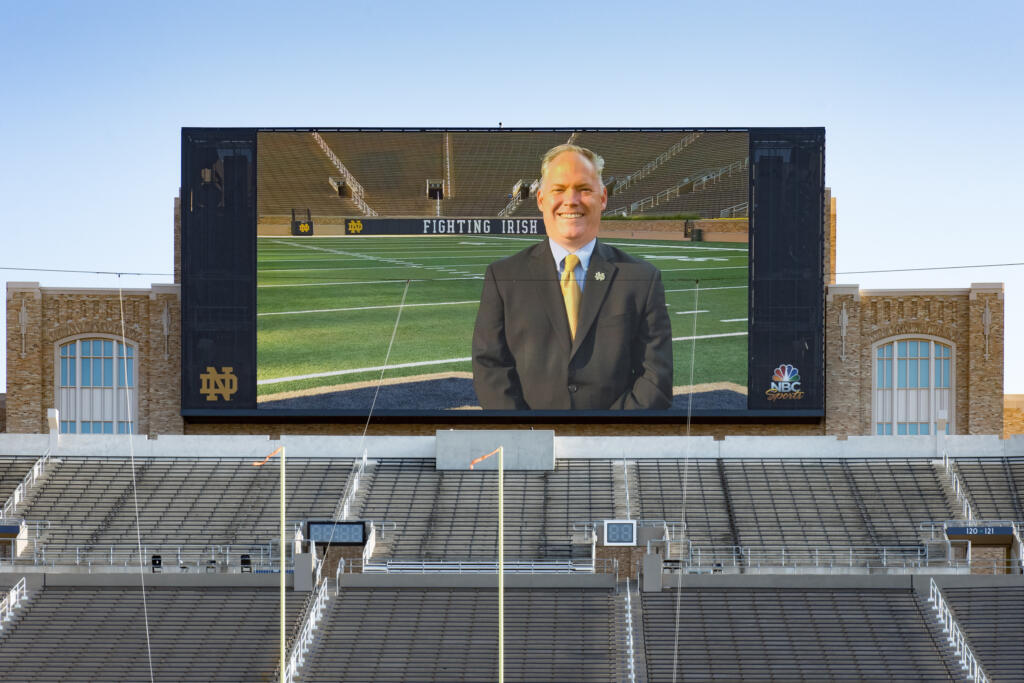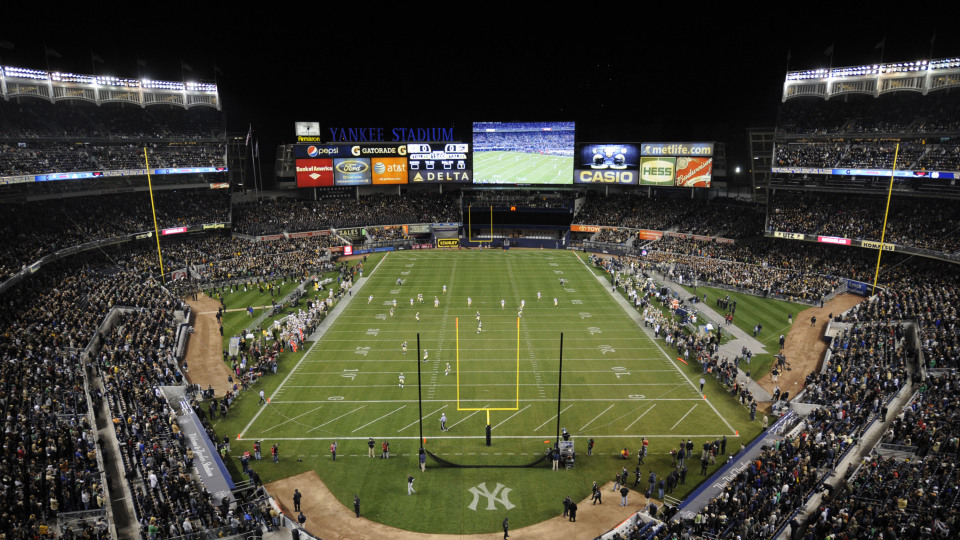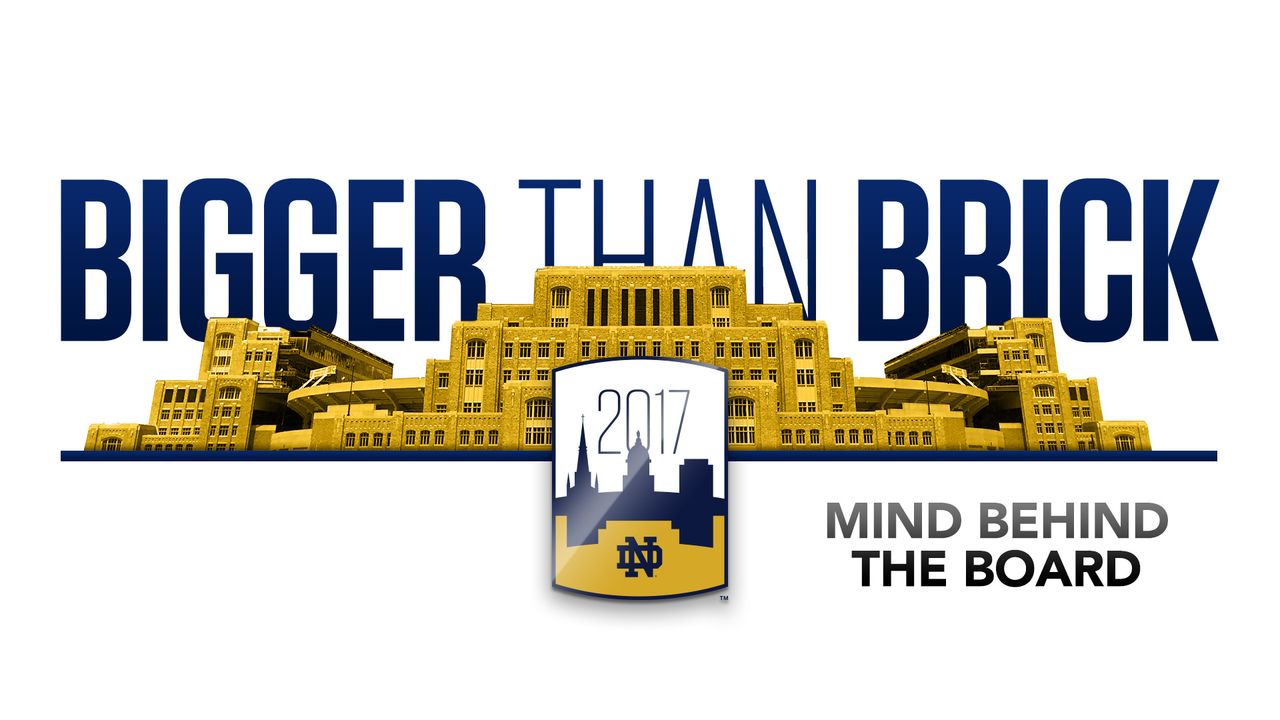Aug. 1, 2017
By John Heisler
Maybe the most obvious of the new fan amenities at Notre Dame Stadium for 2017 is the video board at the south end of the field. At 56 by 94 feet, it’s hard to miss.
Lesser known is Mike Bonner, the 44-year-old executive producer of live events for Fighting Irish Media who is responsible for producing and programming that board.
He might well qualify to star in one of those Dos Equis commercials as “the most interesting man in the world.”
Given the novelty of video boards at Notre Dame, the first year of that item operating at Notre Dame Stadium makes Bonner, at least, holder of one of the more intriguing jobs at the University.
And it’s part of a marriage more than a half-dozen years in the making.

Notre Dame absolutely qualifies as a neophyte in the video board business since this football season marks the first that Irish fans will look to the south end zone to see replays and other content. The University may well count as the last major-college program to add a board to its home facility–after decades when many Irish fans reveled in the minimalistic approach to football in South Bend (no advertising in the venue, simple diagonal stripes in the end zones and an old-school scoreboard with a Longines clock and little more than basic down-and-distance and score information).
All that changes in 2017, and Irish vice president and James E. Rohr director of athletics Jack Swarbrick, Bonner and other Notre Dame officials are confident Notre Dame Stadium can now deliver the state-of-the-art, in-game experience current tech-savvy fans expect. In Bonner’s mind, that begins with the ability to show replays and lots of them. He’ll have access to a dozen of the NBC Sports camera feeds plus nine of his own–with seven of those focused on game action.
“I can’t stress that enough,” says Bonner. “Replays, replays, replays.
“Notre Dame has all kinds of great traditions in football. Those are going to continue and now they are going to be enhanced by our ability to show them visually at a high production level.”
There will be no advertising on the video board–a University philosophy already proven in concept via use of the video boards at Purcell Pavilion for basketball and volleyball and at the Compton Family Ice Arena for hockey. In effect, this is the PBS version in terms of approach.
The beginning of Notre Dame’s video board experience in football goes back to 2009 when the Irish played their first Shamrock Series game in San Antonio against Washington State. For the first time Notre Dame, as the home team, had control and creative license of the in-game video fans would see.
The two corner boards at the Alamodome are only 24 by 32 feet, so their use does not dominate fans’ vision. That changed the following year when the Irish and Army (in 2010 in another Shamrock Series outing) played at Yankee Stadium.
The primary board at Yankee Stadium stands 59 by 101 feet. Without doubt, it’s a major part of the fan experience at any event at that venue. So Notre Dame officials clearly understood this would be an important test case to show they could make use of video assets at that event in a professional and appropriate manner.
The man in charge of the video boards at that game? It just happened to be Mike Bonner, then employed by the Yankees.
“Before he died (Yankees owner) Mr. (George) Steinbrenner was very big into college football and he liked Notre Dame and we knew he wanted this first attempt at football at the new Yankee Stadium to come off well,” says Bonner.

“Since there wasn’t a great deal of history in video board production or game production at Notre Dame, I made some suggestions. I said, `It’d be really great if we could do a pregame show. It’d be great if we can have cameras follow your players off the bus and out of the locker room. Notre Dame was great about saying, `Yeah, let’s do it. Let’s try this. Let’s try that.'”
Born in Brooklyn, raised in northern New Jersey and a graduate of the University of Scranton, Bonner grew up a Notre Dame fan.
“I loved Notre Dame as a kid. Growing up where I did, you didn’t have a lot of college football. And I’m Irish Catholic so you rooted for Notre Dame.
“So, when it came to that game in 2010 I really wanted to put on a good show. It was a prime-time game.
“I remember, (Notre Dame athletic administrators) Jim Fraleigh and Dan Skendzel telling me that Jack Swarbrick was going to come into the (production) booth at some point and so did (University president) Father John (Jenkins). I’d like to think the idea then from the Notre Dame end was, `Hey, this is Yankee Stadium. It’s an iconic brand, you guys have a video board and you go about doing things the right way.’ I had the impression that the Notre Dame people felt like some day, some time, they would have a video board in their football stadium.”
Coming this fall… pic.twitter.com/PwsIiUXoWG
— Notre Dame Football (@NDFootball) July 13, 2017
Notre Dame won the game 27-10–and use of the video board at Yankee Stadium seemed well-received in University circles.
Adds Bonner, “At the end of the game, I remember someone suggesting, `You may have just helped us get a video board.’ And I said, `Well, if you do, I’d be interested, so let’s keep in touch.’ And we did.”
After working for the Yankees since 1999, Bonner left in 2013 for a similar position with the NFL Denver Broncos (with a video board 40 by 222 feet at Sports Authority Field at Mile High). He made sure people at Notre Dame knew he was working for a football team.
“If anything ever happened at Notre Dame, I thought that would make me a more attractive candidate,” he says.
What then was known as the Campus Crossroads Project went live at Notre Dame, and ultimately a video board became part of the plans. Meanwhile, Bonner and the Broncos (with a little help from a guy named Peyton Manning) won the Super Bowl after the 2015 season. Bonner worked the 2016 Summer Olympic Games in Rio and by September he was on the job in South Bend.
“There were times last year when I would think, `Why am I here so early?’ I was a video board guy without a video board,” he says. “But, boy, I’m glad I was. I got a head start on making relationships. I got to experience Notre Dame football, to some extent, as a fan.
“I sat in the stands for multiple games and took notes. A play would happen on the field and I’d crank my neck to the left to look at the video board for a replay and then I’d say, `Oh, yeah, we don’t have one.’ I made a lot of observations and had lots of thoughts along the lines of, `We should do this and we should do that.’ I had a chance to build a nice relationship with the football staff and Coach (Brian) Kelly and I’m looking forward to the season.”
Bonner is confident his experience working for a brand like the Yankees will help him understand and be successful at Notre Dame.
“At both places there’s a lot of history and maybe a little bit of a conservative nature. I never ran a `kiss-cam’ at Yankee Stadium or in Denver–and I’m never going to run one here at Notre Dame,” he says.
“I’m all about history and honoring tradition. It’s about the pride people take in the brand. I often go back to when Derek Jeter talked about Joe DiMaggio saying, `I give my best every single game because it could be the first and only time that people are coming out to the stadium.’ So we owe it to our fans and to people who come to our stadium, whether it’s the first time or it’s the 1,000th time, to put on an appropriate show.
“You’re going to see appropriate football content. You’re going to see video that gets our fans and players pumped up and is very highlight driven. You’re going to find out more about some of the individuals we have playing on this team, the great things they do and the families they come from. We’re doing a feature called `Irishography’ that’s all about, `Why Notre Dame?’ Why is Notre Dame the right fit for Mike McGlinchey, Drue Tranquill or Josh Adams?
“I sat down over the summer with players for interviews and, again, we talk about appropriate content. We didn’t ask questions about what cereal you eat and what brand of toothpaste you use. It was about why they love football, why they love Notre Dame–why they want to succeed in front of these fans and what that means to them.”
Bonner begins with a game rundown that’s constantly subject to change based on what’s happening on the field. He will coordinate a 40-person staff that includes broadcast freelancers as well as Notre Dame staff and students.
“You let the play dictate what’s happening–good and bad,” he says. “When you score a touchdown you ride that moment. You show the replay a gazillion times. You show hero shots of the guy who scored. You let the band go crazy. You let the crowd go crazy.
“The job of game entertainment–it’s very simple. It’s to entertain, to inform and, now, because of social media, to engage. It’s three simple philosophies.”
Bonner will create the show based on his nine manned cameras, two of them wireless RF handheld cameras that can go into the stands, shoot crowd shots, engage the fans. The Diamond Vision board also includes graphic animation packages provided by ANC. The primary board features the most physical pixels in an NCAA outdoor venue.
“I sat down with Jack Swarbrick to work through all this. I sat with Coach Kelly. I’ve bounced ideas off administration. I’ve spoken to our marketing people and met with our band. I’ve met with people all over campus. We made sure we were covering all bases.”
Longtime stadium public-address announcer Mike Collins will still call the game, but now many of the other announcements he made during timeouts and other breaks can be prepackaged video.
Bonner also understands musical selections are challenging since the fan base includes fans from age 4 to age 94:
“I’m bringing in a sports DJ that I’ve worked with in the past. He worked for me at the Broncos, he is working the August 20 event and then the Temple game and Georgia games. Part of his assignment is to educate and help train local DJs who have done this for other sports–so now they’ll be able to carry it on for football.
“Music is a big part of what we do and the band is a big part of that. I’m looking to visually enhance that aspect and make sure we’re all on the same page. That’s my job as executive producer–communicate more than probably is needed.”
Bonner expects to work from plenty of football-related content–as well as show features on academics, sustainability and other campus activities and events. The award-winning “What Would You Fight For?” spots will be shown, as well as the Team Irish and faculty recognitions, plus a variety of other pieces involving institutional messages and features.
“I’ve got a whole lot of content to roll out and test. And that’s a big part of what we do. I’ve got to know what this is like from the fan experience. So, I like to run content and stand out on the field and watch it. Sit in a seat and watch it–not just watch it from the computer screen that it was edited on. It might look great there, it might sound great there — but then you put it into a stadium environment, and you might have to tweak a few things. And then there are things that you run and you say, `Well, that didn’t work. We’re not going to do that again.’ It happens.”
############
While Notre Dame’s marketing staff in prior years has worked off a game script and communicated in-game with the band, the introduction of the video board will significantly raise that coordination requirement level, including with NBC.
“I’ve already met with the NBC staff multiple times,” says Bonner. “I went to Stamford (Connecticut, home of the NBC Sports offices and production facilities) and met with Rob (Hyland, NBC producer of Irish games). Rob was the producer at the game at Yankee Stadium in 2010, I happen to know Pierre (Moossa, the NBC director) and I know Pierre’s wife Ashley who works at the YES Network. So, we have some relationships there.”
Bonner’s inside access means he can show the Irish team live as it says its pregame prayer, walks down the stairs past the “Play Like A Champion Today” sign and then into the Notre Dame Stadium tunnel. Next comes a 75-second intro video. He expects all those live shots on the board to play significant roles in building crowd energy as the team prepares to take the field.
Once the game ends, Bonner and his staff will produce a postgame show from the South Club with a reporter field-side to interview players.
Bonner also understands lots of Notre Dame fans are wed to traditions. That’s one reason he expects to continue to use Sergeant Tim McCarthy safety messages–except this year they’ll be delivered on video by Notre Dame fan favorites including Tim Brown, Joe Theismann and Jerome Bettis.
“We’ll continue to do things like that,” says Bonner. “And hopefully we’ll build some new traditions where people will say, `Hey, that’s Notre Dame. That’s what that’s all about.’
“The idea is for what we do to build that momentum that gets the crowd into it. Those are going to be the things that are the big difference.
“There’s nothing cooler for someone who produces a show then to have the reaction that you hope happens from the crowd from a video you roll or a replay you show. So, a great catch happens and you hear the crowd go, `Ohhh.’ Or the video ends and they just go ballistic. That’s one of the coolest rushes we have. And those are the things that we’ll be looking to achieve here.
“I think it’s going to be a great show, I really do. I think we can do it because we have people in place and we have buy-in from the staff and the University.
“I’m looking forward to it.”
For a life-long Notre Dame fan like Bonner, in a way he’s been looking forward to it for a long time.
He hopes fans will quickly become accustomed to what the video board brings to the Saturday experience.
For now, anyway, he’s got the most interesting job on campus.







